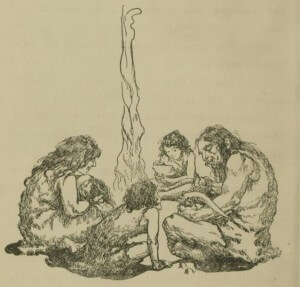
Imagine the earth in 50,000 BC. Mankind is entering the final stages of its evolutionary journey from animal to human. How is he living? And what is he eating? What types of foods? And how are they processed? We have all heard that we need to eat a natural diet, full of fresh fruits and vegetables, and low fat. This is generally true but somewhat misleading considering what foods mankind has evolved to eat.
Many of the facts about how evolution works are misunderstood, although it is very complicated, here is a fictional example to help explain in basic terms how evolution works, especially regarding food digestion and health benefits: A long time ago in jungle in Africa there was a tribe of people. They all have similar genetics but due to breeding with other tribes and mutation there are slight variations of every kind: some of them are lactose intolerant, some of them need more calories to be healthy, some of them are better hosts for certain probiotics( good bacteria in the digestive system to help break down food), some of them need certain foods to help regulate blood sugar. The way evolution works is that the people who are thriving in this environment are more likely to be healthy, attractive and reproduce. So they will pass on their genes and the next generation should be better equipped to handle the environment. The ones that are not thriving will be less likely to pass on their genes, so those negative traits will be less common in the next generation. Mutation continues to occur at a regular rate and introduce new genetic material, good and bad into the population. Also environment changes regularly and requires different traits to thrive.
What foods were these common ancestors of ours eating? They didn’t have science or modern nutritionalists to tell them what was healthy; their primary goal was to keep from starving, with limited food that meant get as many calories as possible. So they did, humans evolved on a diet of eating anything and everything they could find that was not poisonous, and even some things that were poisonous, but not in small quantities. We all know they ate mammals, fruits, and vegetables, but here are some of the forgotten edibles that humans are meant to eat: reptiles, amphibians, Arachnids, slugs, worms, ticks, insects, arthropods, bee honey, inner tree bark, fungus other than mushrooms, and a very wide variety of leaves and seeds. Some of these things are taboo in many cultures and some of them might be unhealthy if not prepared properly. But this is the best diet for mankind because it is what evolution has led us to.
The majority of the foods we commonly eat consist of roughly 100 to 500 organisms, some estimates are much lower. The number of edible organisms on the planet is somewhere between 50,000 and 100,000 depending on how they are defined. The number of good tasting and enjoyable edibles is estimated to be between 12,000 and 25,000. With these numbers we can see what we are missing.
Modern nutrition has us focused on vitamins, minerals, and calorie intake, which are very important but these tens of thousands of edible plants and animals also contain complex byproducts that can affect our health in positive and sometimes negative ways, if over-consumed. Many of the medicines we have today are derived from plants and animals such as codeine, atropine, benzyl benzoate, caffeine, heparin, menthol, morphine and many more. Certain plants also have benefits to people such as antibiotic and antiparisitic properties, balancing blood sugar, many different types of antioxidants and other cancer fighting components. When eaten in their natural form in the right quantities, these plants and animals give us a balanced and relatively safe way to get the benefits from their compounds and byproducts. One example is Rose of Sharon(Hybiscus syriacus) which is know to reduce blood pressure when taken on a regular basis. High blood pressure is a common problem today, and medicines often have side effects. Drinking Rose of Sharon tea or eating leaves and flowers could help people to lower their blood pressure, with no bad side effects.
Now we see what potential benefits this large variety of plants and animals has to offer. There is one more part to this story though. All people today still have different genetic makeup and require different nutritional needs. Our ethnicity will help us to determine a little better what diet is best for us. Some conditions such as hypoglycemia, lactose intolerance, and obesity are more common in certain ethnic groups. We know now that variety is very important and we should always be asking the question: what is my ancestral diet? Because this is what the evolution of your ancestors has lead to. This is the diet that you were made for.
Many of our readers find that subscribing to Eat The Planet is the best way to make sure they don't miss any of our valuable information about wild edibles.
See our privacy policy for more information about ads on this site






